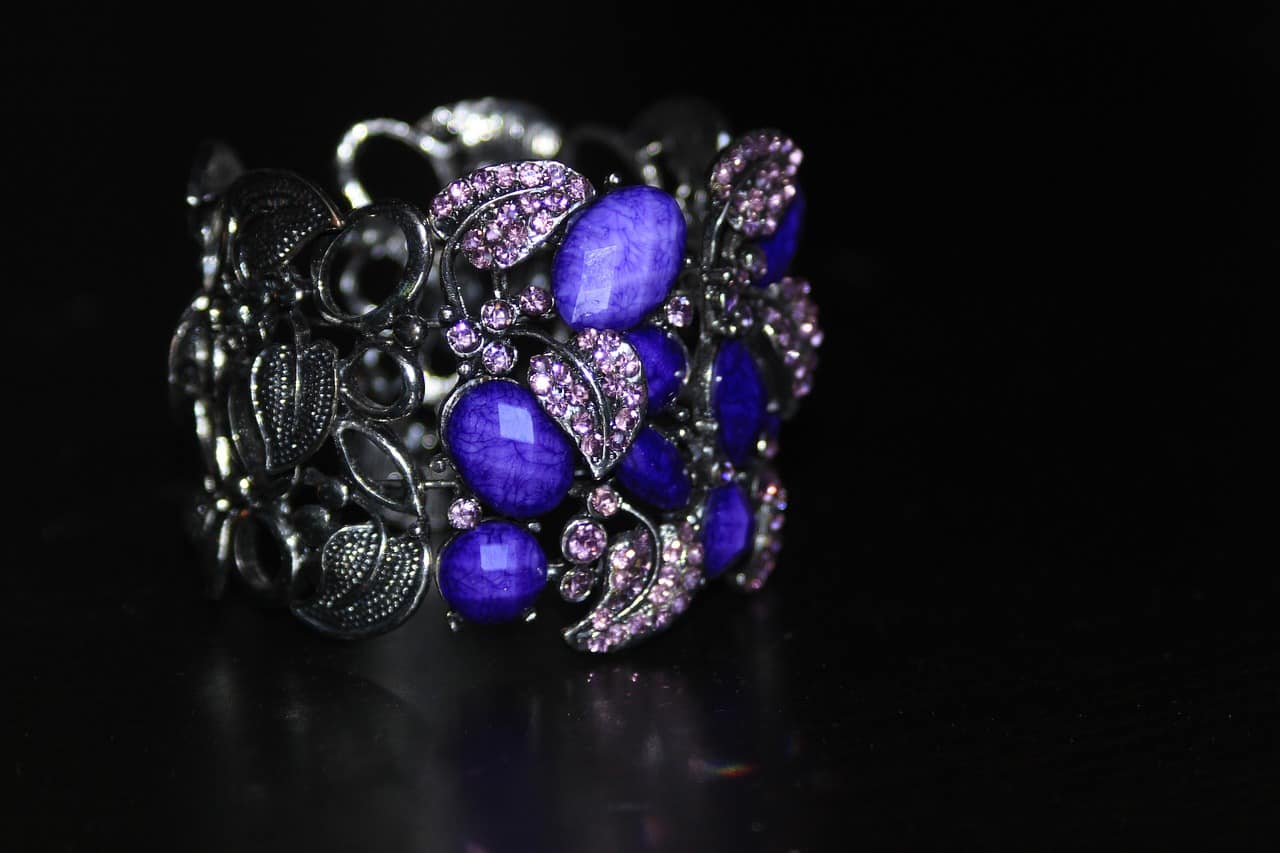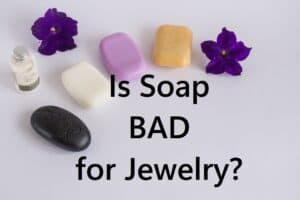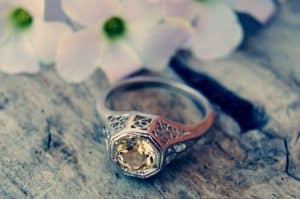Remember those times when you are excited to get a jewelry piece out of the closet and you find that it has turned black! I have been there too and have been gutted enough to have put in extensive research into the subject.
Your jewelry, be it composed of any metal or alloy, is exposed under environmental and physical influences, which can trigger reactions and turn it black. So, what are these influences which cause jewelry pieces to turn black and how to get around them? Well this is what we are here for today, so let’s get talking!
Why does jewelry turn black?
All objects found in nature have a natural tendency to return to a state where it has lowest energy. Metals are generally found in oxides, which are their lowest energy states. Therefore, all metals have natural tendency to move to their sulphide or oxide form. A lot of these sulphides or oxides may have black or dark green appeal. Thus, a piece of jewelry comprising these metals appears black in colour.
General Causes for Blackening
Before we go on and understand how different metals turn black, let us understand what are the common factors that cause blackening of metals.
1. Exposure to moisture
Moisture in the air drives the process of oxidisation considerably. The dryer the air is, lesser are the chances of a metal turning black.
2. Reactive to Oxygen
As we have read above, a lot of precious metals are stable and do not react with oxygen in the air. However, the other alloys used may react and turn black. The more reactive a constituting metal is to oxygen, higher are the chances of your jewelry turning black.
3. Exposure to beauty products
The chemicals or even organic compounds present in your beauty products might be damaging your jewellery and you might not even be aware of it. There is a rage of paraben and Sulphate free products these days. One must opt for such products as in addition to being gentle on your skin, these also go easy on your jewelry.
Following are common beauty products that contain sulphur or other reactive elements
- Perfumes or deodorants top the list as they are generally applied post wearing jewelry and are sprayed. Thus, causing a larger area to come in contact
- Creams, lotions, sunscreen, body butters, moisturizers
- Shampoos, bathing gels and soaps
4. Reaction with topical medicines
If you are using a certain topical medication on regular basis, it may be reacting to the metals or alloys you are wearing. This is generally easier to identify.
In such a case, only jewellery worn on or around the affected part will show signs of blackening. While at the same time, jewelry worn on other parts, having the exact same composition might be unaffected.
5. Contact with sweat and body oils
As sweat contains both: moisture and harmful substances, it plays a great role in triggering or increasing blackening of metals.
Human sweat consists of high amounts of sodium chloride. There can be other substances like urea, lactic acid, ammonia, chlorine which are generally found in sweat. These may cause the constituent metals of jewelry to react and turn black. e.g. silver and copper present in your jewelry can form silver chloride or copper sulphide, which are both black.
However, the behaviour can be different for everyone. Also, the composition and amount of body oil secreted from the pores may be different for everyone. These factors also depend on weather conditions and several other factors. Thus, causing the jewelry to behave differently for different individuals under different conditions.
6. Exposure to high temperatures
A lot of alloys form black coating at high temperatures. E.g., copper forms a black oxide at high temperatures. If you like taking hot showers or spending time in saunas, not wearing your jewelry may be a good idea.
7. Exposure to other chemical substance
Apart from harmful compounds already present in air, there are other chemicals we often encounter. These might also be causing our jewelry to turn black.
Here is a list of a few chemicals I could think of:
- Exposure to chlorine because of swimming with jewelry on
- Use of sanitizers on or around jewelry
- Acidic and sulphur compounds in food products
- Household Cleaning solutions
- Hydrogen peroxide
- Use of natural gas in kitchen for cooking as it contains sulphur
8. Improper or incorrect storage
Do not just toss your jewelry into a cabinet or drawer when you take it off. Keep in mid the following when you store your jewelry, even if you are only going to keep it inside overnight.
- Use air-tight bags or containers
- When using zip-lock or similar bags, remove any excessive air from the packet using your hands
- When using boxes, ensure that the boxes seal completely without letting air pass through the box.
- Invest in some good anti-tarnishing strips. Keep these in the boxes or bags when strong jewelry for a longer period.
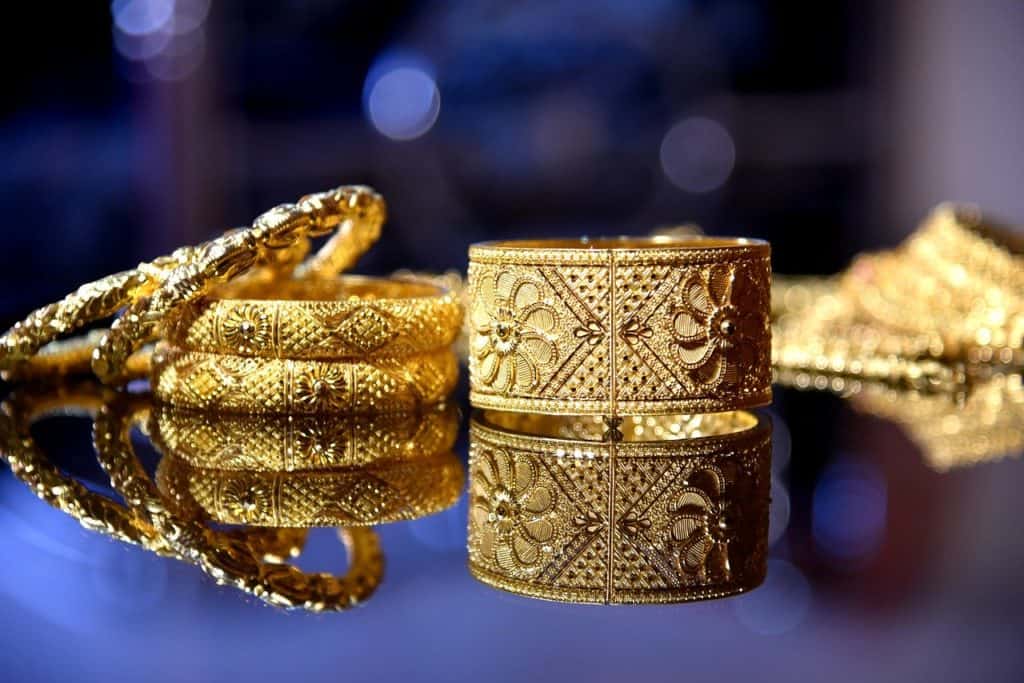
GOLD JEWELRY
Well, we all know that pure gold (24 Karat) is least reactive. The best part is it does not even react with oxygen. This trait helps in keeping it every shiny. But to most gold jewelry lovers dismay, ornaments or jewelry items cannot be crafted out of pure gold.
However, pure gold needs to be added with other metals and alloys in order to increase its durability, strength and hardness.
Why is my gold turning black?
In your piece of gold jewelry, it is not the gold that is turning black, but the alloys used. Gold is always mixed with a number of metals or alloys which add strength to the piece of jewelry.
A lot of these metals react with oxygen. These metals may also react to different gases or chemicals like sulphur. These may be present in the air or on other objects the piece of jewelry comes into contact with. Thus, causing the entire piece to look black or tarnished.
What does it mean if gold turns black?
If your gold is turning black, it means it clearly has other metals that are more reactive than gold! These metals are prone to corrosion and are making the entire piece look tarnished and unappealing. Be aware that more the quantity of this reactive metal in your jewelry, the blacker your jewelry will appear to be.
Out of the metals used as alloys with Gold, Copper and Silver are the ones that are most commonly used. Unfortunately, both these metals oxidise easily and have a high tendency of turning black. (Zinc, Nickel)
Below, I have tried to sum up different metals which are commonly used with Gold, and their tendency to oxidise. If your gold jewelry has turned black, I recommend you check what metals are used as alloys with your jeweller. Also, keep this in mind when you make your next gold jewelry purchase.
PLATINUM JEWELRY
In the past decade or so, Platinum has been a really sought-after precious metal. Being lasting, precious and rate, Platinum wedding bands and rings gained popularity! Let us find out if Platinum turns black.
Does Platinum go black?
Good news is, just like pure Gold, Platinum does not turn black easily. Rather, pure platinum retains its white colour throughout its life as it is thoroughly non-corruptible. Let us find out more about the metal and its tendency to turn black.
Why does Platinum turn black?
Platinum does not turn black easily. It might appear dull and the patina may be on the darker side after years of use. The reason for this is the way light reflects the surface when there are very mild and un-noticeable dents or scratches on the surface. It is not the metal that tarnishes or reacts with other compounds.
If you feel that your platinum jewelry is turning black and it is not caused by the scratches on the surface, you must check the exact composition of your piece of jewelry. It is not common for Platinum 950 or Platinum 900 to turn black. An article with other additives may turn black depending upon its constituent metals.
Let me give you a brief description on how these are different.
What is Pure platinum (Platinum 950/Platinum 900)
A piece of platinum jewelry is referred to as “pure” when the percentage of platinum in it is more than 90%. Any piece of platinum jewelry in which the percentage is less than 90% is not considered pure.
Platinum pieces with a purity of 95% is called platinum 950 while those having purity of 90% are marked as platinum 900.
These pieces retain their sheen as these only contain very little traces of other metals.
Platinum with less than 90% Purity
Platinum that is less than 90% pure can have a different metal, or combination of different metals. The blackening of these pieces will be governed by the other constituent metals in the piece.
A lot of these pieces have silver as a major alloy as it also has a similar silver-white colour. Silver oxidises and turns black easily when exposed to air and moisture. Other constituent metals may also be causing your jewelry to turn black. You need to check the exact composition with your jeweller.
RHODIUM JEWELRY
Rhodium in itself is non-reactive and does not tarnish or oxidise easily. Being a member of Platinum family, it is silver-white in colour and has an amazing sheen to it. Pure Rhodium will maintain its sheen through its life and will not turn black.
Then how does Rhodium plated jewelry turn black? Let’s find out!
What does it mean if rhodium turns black?
Rhodium is majorly used for plating different metals and jewelry is not crafted using only Rhodium. There are many reasons behind it. High cost, low availability and hardness of the metal are a few major reasons behind it. Additionally, the layer of the metal that forms on the base metal as a process of plating is only a few milli meters thick
Therefore, if your Rhodium jewelry is turning black, it means that the outer layer is chipping off and the underlying metal is getting exposed. Based on what base metal your piece is crafted out of, your jewelry may be tarnishing and turning black.
In order to find out the exact reason, you need to understand the exact composition of your piece of jewelry.
What is black Rhodium?
Just like there is no metal as white-gold, there is no such thing as black rhodium. In nature Rhodium occurs in silver-white finish. Black Rhodium is not natural in occurrence.
However, these days we see a black coating of Rhodium on certain pieces. The process of crafting such pieces of jewelry with black plating is different.
Small amounts of tin sulphate, arsenic trioxide and tellurium oxide are added while plating Rhodium on a piece to get a back tone.
Black rhodium plating can cost you more. While it lasts nearly as long as white rhodium plating does, it is more noticeable as the underlying metal has a colour different than black (generally white or silver)
SILVER JEWELRY
Out of all precious metals, silver is most “affordable” and it also looks amazing with different range of outfits. It also compliments almost all skin tones which makes it a favourite among many. Let’s now discuss blackening of silver in detail.
Why do silver articles turn black or why does silver go black?
Silver reacts with Sulphur present in the air and forms silver sulphide which is black in colour. The most common sulphur compounds present in air are Sulphur dioxide and hydrogen Sulphide.
This is the reason why a lot of silver jewelry or other silver articles like silverware turn black.
Can real silver go black?
The answer to this question is yes! As discussed above, real silver undergoes a chemical reaction when it comes into contact with sulphur compounds in the air.
Does sweat turn silver black?
Yes! Sweat contains sodium chloride in large quantities as discussed above. Silver reacts with sodium chloride to form silver chloride which is black in colour. Other harmful substances may also be present in sweat. Although, every person sweats differently in terms of amounts and chemicals released through their pores. Therefore, the results may vary for individuals wearing the exact same composition of jewelry.
Why is a Sterling Silver 925 ring turning black?
Again, copper in your sterling silver 925 might be causing your jewelry to turn black, Copper reacts with the compounds present in air faster in comparison to silver. It also reacts with oxygen to form copper oxide which is black in colour. Additionally, tin in sterling silver might be reacting with acids and compounds your jewelry is coming in contact with.
Why does silver plated jewelry turn black?
Silver plated jewelry has a thin layer of silver coated over other metals. The underlying metal can be any, but is it generally brass. Just like silver, brass oxidises when exposed to moisture. Both silver and Brass oxidise to form a black or dark green layer. This is the reason why silver-plated jewelry turns black.
FAKE/IMITATION/COSTUME JEWELRY
Imitation or fake jewelry can be found in different metal compositions. A lot of pieces contain inexpensive and coloured stones.
Why does fake jewelry turn black?
Fake jewelry is made of alloys of low quality or cheap metals. While the exact composition varies, a lot of fake jewelry articles have either brass, copper in large quantities. Both of these metals have a tendency to turn black over time, giving your jewelry a dull and black appeal. Higher the percentage of brass or copper in your item, more quickly it will turn black.
Does fake silver turn black?
The answer to this question is yes! Although, the rate at which your item turns black depends on the exact composition of the piece. A fake silver jewelry might consists of steel, lead, nickel, copper and zinc. The pieces having higher percentage composition of copper will turn black faster than those having steel or zinc in higher quantities.
REMOVAL OF BLACKENING
Once blackening has occurred, it is important to understand how you can reverse it and restore the looks of your jewelry.
GOLD
Gold is the most commonly worn metal which makes it imperative to understand how we can safely clean it to get black tarnish off. Let’s dive straight into it!
How do you clean gold that has turned black?
If you are planning to fist try and clean your jewelry at home, start with the most basic technique. I have tried the following and it helps me keep my jewelry looking shiny between visits to jeweler. Trust me, the visits can be many years apart 😀
- Heat some water in a pan and add the mildest detergent you have.
- Take your article and immerse it in the warm (not boiling) water. Keep immersed for about 15 minutes.
- In case your jewelry does not have any gemstones or coloring, you can add 2 parts ammonia to 1-part water as well at this stage. I usually avoid this step as it might lead to discoloration of certain parts or gemstones
- Use a soft bristled brush to gently clean the article. Especially target areas that have intricate design or detailing. Be very careful and gentle with this process as you surely don’t want to bend or break any part. I use this brush for the job and haven’t faced any issues so far. The bristles are really soft.
- Use lukewarm water to rinse
- Keep on a soft muslin or cotton cloth. Any other soft natural cloth which absorbs moisture quickly can also be used. Or else, towel dry and place on paper tissue.
- Store in an air-tight container or wear the piece as soon as it is dry. Do not leave in open for long.
In case you are comfortable with this method and wish to move a step further, you can use a cleaning solution formulated for gold. Please red the instructions carefully and buy one which is made specifically for gold. Also consider any gemstones or other stoned your article might be having.
If you are still unable to get the black tarnish off, or are not confident about cleaning it at home, visiting your jeweller is the best thing to do as they know the best.
PLATINUM
Platinum is a metal that is 60% denser than gold and has a closely packed molecular structure. It rarely turns black and only looses its sheen over the years. It develops a mildly dull patina over many years.
Platinum articles can be cleaned in the same way we cleaned Gold jewelry above. In a similar fashion, if you wish to go a step ahead, you can check out platinum cleaning solutions available in the market.
RHODIUM
You will hardly find any piece of jewelry made purely out of Rhodium. Articles have a very thin coat of Rhodium over their surfaces which might get removed easily. Therefore, you must be very cautious while cleaning Rhodium jewelry Only use soft cloth to clean such pieces.
SILVER
The good thing is, blackening of silver is only a change at the surface level and can be completely overturned. Cleaning silver is fairly simple and you will see great results in the first clean itself. There are many different techniques for cleaning silver at home. I will discuss the one that has always worked for me.
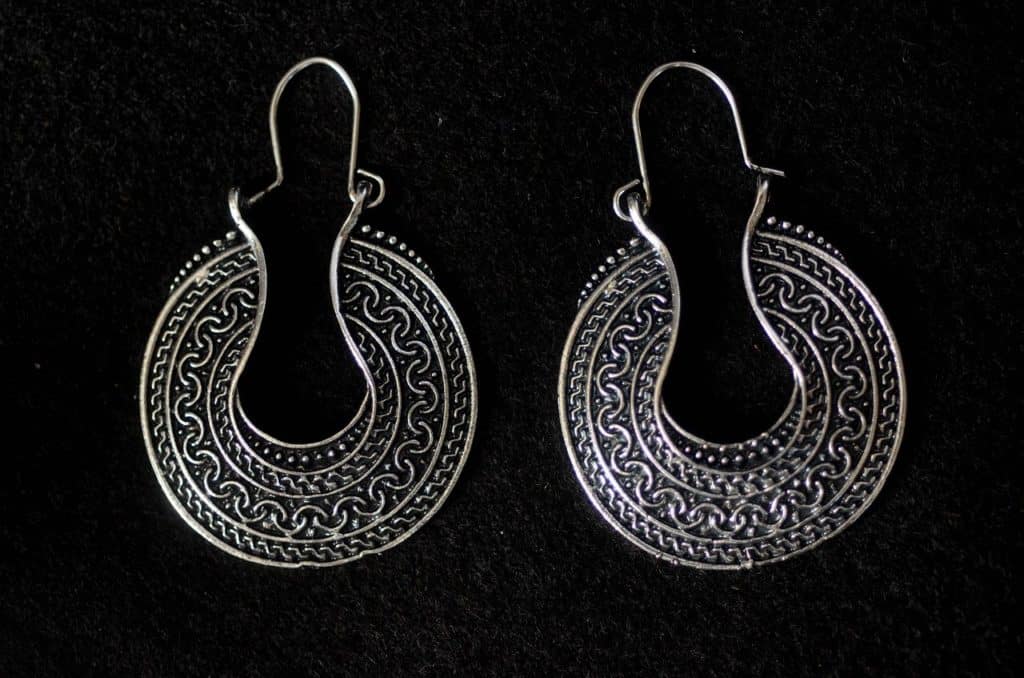
How do you remove oxidation or clean silver that has turned black?
Follow these simple steps to get clean and shining silver jewelry:
- Take a dish that can easily contain your article
- Line the bottom with aluminium foil
- In a separate container, boil some water and slowly add Sodium Bocarbonate (also known as baking soda)
- Keep the piece you want to clean in the dish from step 1, that has aluminium foil at its base
- Slowly pour the water having baking soda over your jewelry
- Let it sit for about 20-30 minutes
- Take out your clean piece from the container
If you wish to go a step further, you can clean silver by keeping it dipped in a solution of water and lemon juice or even water and vinegar for some time. You can also use tooth paste and a brush to clean your jewelry. Avoid these methods if your jewelry has stones.
IMITATION JEWELRY
Imitation jewelry is at the highest risk of turning dull and black. You must clean a piece more often in case you wear it often. Generally, cleaning it once every month can be helpful. Or else, you can clean it when it shows sign of fading or tarnishing.
How to clean imitation jewelry?
Before you start cleaning your imitation jewelry, please be informed that jewelry that has stones is cleaned differently than jewelry with no stones.
Follow the below steps to clean your imitation jewelry:
- Use a mild dish washing liquid or baby shampoo
- Gently clean the surface using a toothbrush or a q-tip brush. Keep the brush slightly tilted when you are using toothbrush to clean. A lot of good quality imitation jewelry comes with a thin layer of protective coating on the surface. If you rub it too hard, it might get damaged. This might have a reverse effect and may cause your jewelry to turn black fast.
- Wipe the surface with a dry muslin or cotton cloth
- Air dry the jewelry or else you can use your hair dryer at cold air setting. Hot air can damage colour or outer layer.
- Store in air-tight bags. Covering in a soft fabric and storing pieces separately in air-tight bags or containers also further cuts down the probability of a piece turning black in storage.
For certain pieces of imitation jewelry (mostly the ones that have silver finish), solution of lemon and water, or even rubbing with a half-cut slice of lemon works wonders. You can also try using toothpaste on such pieces.
If your imitation jewelry has stones, follow a similar regime but try using as little liquid as possible. Also, try to keep the liquid away from the stone. Any moisture accumulating under the stone may cause damage to the gum which might result in the stone falling off from the piece. Certain solutions may also damage the underlying clear polish, making the stone look unappealing.
PREVENTION
We all know that is is best to prevent an issue than curing it later. So, in this sectiion I would like to share some hacks or techniques I use to prevent my jewelry from turning black.
GOLD
When it comes to preventing gold jewelry against turning black, keeping it clean and dry goes a long way. Making it a habit to clean it with a soft and clean cloth and storing in an air tight container whenever you remove it will delay blackening substantially.
Apart from keeping your jewelry dry, try and keep it away from any cosmetics or body sprays you use. Prefer wearing your jewelry after some gap once you have applied your lotions and fragrances. This would help the product to get settled and absorbed by your skin. Thus, further limiting the amount that comes in contact with your jewelry, making it last long.
SILVER
There are things that you can keep in mind when you buy silver jewelry. There are other measures that can be taken for prevention against blackening for already owned articles.
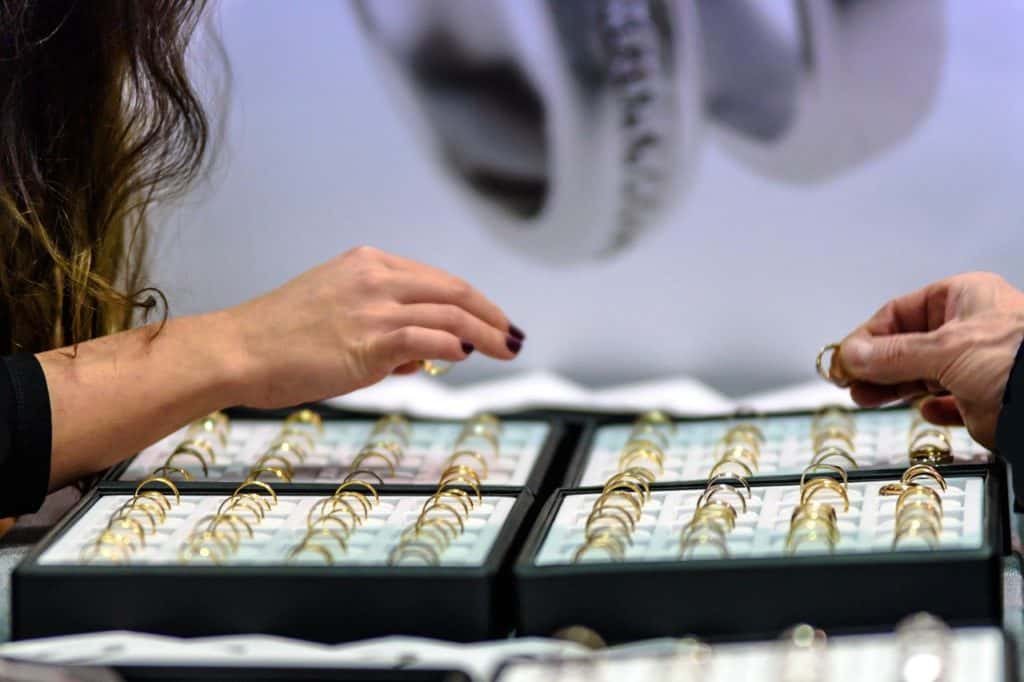
When you buy
- A lot of jewellers prefer plating silver jewelry with a very thin coating of rhodium. Rhodium as we know, is far less reactive in comparison to silver, keeps your article safe. This however is not a permanent solution as Rhodium plating eventually chips off. This might take a couple of years or even more. This depends on many factors. E.g. a pendant or a pair of earrings would stay shinier for a longer period in comparison to a ring or a bangle.
- A few tarnish free alloys are gaining popularity these days. Argentium is one such alloy. As we know that Copper in silver accelerates tarnishing, it has been replaced with metaloid Germanium. You can check other similar options with your jeweller while buying silver jewelry. These might be slightly more expensive than regular silver jewelry. However, these might be worth buying.
Preventing Pre-owned silver from turning black
There are a few tricks that work wonders against blackening of silver.
- Keep your jewelry clean
Once you have removed it, clean it regularly with a mild cleaning agent. It can be as basic as a mild liquid soap (free from sulphur).
Even cleaning a piece that you never remove with a cotton or muslin cloth also makes a great difference. It helps in removing oil or other chemicals that the article might have picked up from your skin, deodorant or other products.
Whenever I remove my silver jewelry, I clean it using this cloth before storing it away in an air-tight container. This helps clean all the dirt and even fine layer of tarnish from the piece.
- Keep it dry
As we know moisture favors tarnishing, keeping your jewelry safely stored in dry areas will keep it safe. You can use basic things to store your jewelry like Ziplock bags, air tight containers. For added safety, you can wrap your article in a cotton cloth and store it in any air-tight container or zip-lock bags.
- Try Anti-tarnish strips
For the pieces you do not wear on daily basis, you can add anti-tarnish strips to the storage bag or container. These strips are specially crafter to be reactive and work by reacting with the harmful compounds in the air. Thus, preventing your precious jewelry against tarnishing. These can keep your jewelry safe for about 6 months to 2 years, depending on the quality and size of the strip.
I use these anti-tarnish strips for my silver and they work really well. You can check out from the many available options online or with your jeweler, if they sell them.
IMITATION OR FAKE JEWELRY
Keeping imitation jewelry safe against blackening is tricky as it is quite prone to blackening. You need to follow certain things and make them a part of your routine. Just as discussed above for Silver, you must keep in mind the following:
- Keep your jewelry clean
- Keep it dry.
- Try incorporating a few changes in your daily habits. E.g., put on your jewelry post you have applied your perfumes, lotions etc.
- Always store it in air-tight containers. When using zip-lock bags, take out any excessive air by gently running your hand through the bag before sealing it.
Conclusion
I have tried my best to compile everything that I researched in this topic and the tricks that worked for me. I hope these tips are of some help to you and you are able to keep your jewelry ever-shiny!

